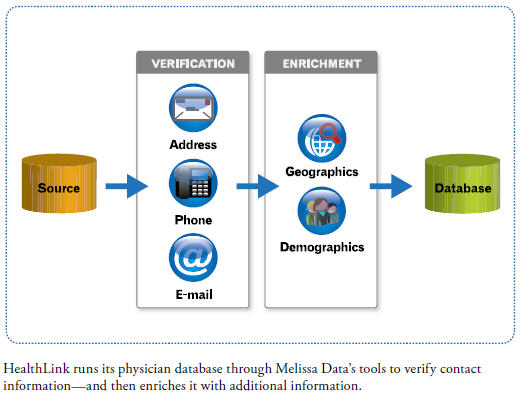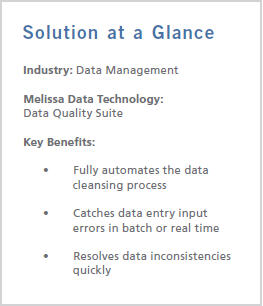CASE STUDY - HealthLink Dimensions Combats Constantly Changing Data with Verification Tools
Leveraging the largest multi-sourced database of active practicing physicians, HealthLink Dimensions provides unique, accurate, and content-rich healthcare database products that help the pharmacy, healthcare, medical device, and insurance industries efficiently target their primary markets.
Commentary by Chris Lloyd, Director of Database Services, HealthLink Dimensions

The Challenge
Leveraging the largest multi-sourced database of active practicing physicians, HealthLink Dimensions offers flexible data solutions that facilitate multi-channel marketing and communications. Based in Atlanta, Georgia, HealthLink Dimensions provides unique, accurate, and content-rich healthcare database products that help the pharmacy, healthcare, medical device, and insurance industries efficiently target their primary markets.
HealthLink has demographic files totaling more than 2.3 million physicians and allied health professionals—complete with titles, specialties, and multiple identifiers, such as DEA number, UPIN, state license number, NPI number, and tax ID, with linkage to hospital and group practice affiliations.
With so much data to collect and manage, HealthLink recognized it was critical to implement a solution that would clean and standardize all of its multi-sourced, multidimensional data—a daunting task, to say the least.
Consider also that data constantly changes and stagnates through time. Various factors contribute to this data degradation. Physicians move their practices, work in multiple offices, or retire. Trying to communicate with physicians via e-mail can be even more challenging, as physicians sporadically change their e-mail addresses.
“Healthcare data changes quite often. We see anywhere from a 2 to 3 percent change in demographic data every month,” said Chris Lloyd, HealthLink’s director of database services. “So we are constantly validating and updating our data.”
Lack of Standardization
HealthLink found that its biggest challenge was the lack of standardization, a common problem when integrating multiple sources of data. Duplicate records also posed a threat to its system.
“Be it claims data, PPO network data, pharmaceutical called-on sales lists, or even industry type databases, such as DEA and NPI, we pride ourselves on maintaining one of the most accurate SQL Server databases,” Lloyd said. “To maintain this high standard of accuracy, you must get your incoming data into a certain standardized state that allows you to load it into your database.”
The most common types of errors found in their records were inaccurate and incorrectly formatted phone and fax numbers. HealthLink also discovered that some physicians practice in multiple locations. How does one maintain multiple addresses for the same physician?
The Melissa Data Solution
In the past, HealthLink utilized separate, independent products for address standardization, name parsing, geocoding, and phone standardization. But the company wanted to have a comprehensive collection of tools from a single source provider.
HealthLink was looking for developer tools they could customize to their needs. The company chose Melissa Data, a data quality and data enrichment solution provider headquartered in Rancho Santa Margarita, California.
HealthLink uses Melissa Data’s Data Quality Suite, a collection of multi-platform solutions for address verification (Address Object), phone verification (Phone Object), e-mail validation (E-mail Object), and name parsing (Name Object). The company uses the suite to update and validate millions of records each month.
“Data Quality Suite allows us to clean, hygiene, and standardize this data so that we can create one of the most accurate physician and allied professional databases in the industry,” Lloyd said. “The suite enables us to format the multiple sources of incoming data so when we load our database, we have no duplication.”
HealthLink liked Data Quality Suite’s flexibility and ease of integration. “The main strength is its ability to easily integrate with our custom .NET applications and SQL procedures,” Lloyd said. “We have written several internal applications and services that use each of the objects of Data Quality Suite. We haven’t really encountered any major weaknesses yet, especially as compared to competing products.”
Adding Location Intelligence into the Mix
Aside from verifying and standardizing data, HealthLink wanted to add location intelligence to data to help clients gain better insight into critical decisions. HealthLink implemented Melissa Data’s GeoCoder Object into their operations for this purpose. The goal: utilize geocoded data to ascertain proximity and distance to physicians’ locations, service areas, and so on.
“GeoCoder allows us to append longitude and latitude to every address, and we use it in a couple different ways depending on the client. Our data aggregator clients who use our data for directory services can look for physicians within a certain mileage,” Lloyd said. “List clients come to us looking for certain specialties—say cardiologists or internal medicine. We can easily provide the results in and around statistical geographic areas.”

But the most exceptional way HealthLink utilizes GeoCoder is in managing multiple addresses for the same physician. “GeoCoder allows us to maintain multiple addresses for the same physician even when we are receiving and loading the data from more than one source,” Lloyd said. “We use the mileage distance between addresses to write proprietary business rules to locate physicians who practice in multiple locations, and even across state borders.”
The Derived End Product: Massive Database—Cleansed and Standardized
Utilizing all components of Data Quality Suite and enhancing their data with geocoding technology has empowered HealthLink with the most clean, standardized, and accurate physician demographic data around.
“To compete in the physician demographic arena, you must have clean, accurate data,” Lloyd said. “As a multi-source data collector, we could not do business without a way to clean and validate that data. We feel that both our data quality and the tools and processes we use are what separate us from our competitors.”

Working Smarter, Not Harder: Realizing Cost Efficiencies
“While some companies use a ‘brute force’ method of making thousands upon thousands of phone calls a year to validate data, we leverage technology, great tools like Data Quality Suite, and superior industry knowledge to keep our data accurate and clean,” Lloyd said. “It allows us to minimize labor costs. With the right technology and processes in place, you just don’t need to make that many calls—you only need to call a significant statistical sampling. Inaccurate data (both claims and demographic), including fraud, waste, and abuse, is a billion-dollar industry, so any type of data improvement we can do truly does save our clients a lot of money.”
This article originally appeared in the issue of .